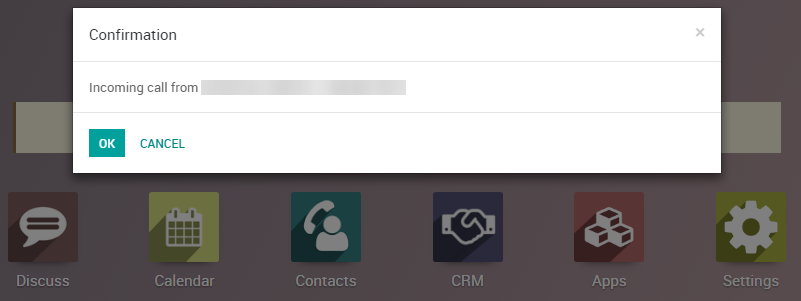Question: What do you get when you cross an open-source, cloud-based suite of business applications with the open API of a cloud-based business phone service?
Answer: You get...
- Phone calls that arrive with screenfuls of data on their callers. Just like customer service reps at high-tech, high-volume call centers, you get the relevant database record you'd be manually retrieving during the call, be it customer and buying history, vendor and outstanding invoice, user and tech support ticket, employee and time sheet, or any of many other caller/database combinations.
- Data records with the ability to make phone calls, aka click-to-call.
- Automatic record-keeping on all your interactions across the business. No more relying on human discipline to note a call; no more dealing with a different call logger for every app. Every application in the suite retrieves and adds to the same integrated store of call information. You get a complete view of all interactions with each customer/employee/vendor/etc., no matter the context.
The app suite we're talking about is Odoo, a seven-year-old upstart now hosting over 30 integrated applications, including everything from accounting, marketing, HR and point-of-sale systems, to inventory, product lifecycle management, ERP and CRM. The phone service marrying these integrated apps is, of course, OnSIP, our award-winning, veteran, cloud-based phone system.
Companies who take the OnSIP option with their Odoo subscription get full-fledged OnSIP accounts, with all the phone features, auto attendants, hunt groups, video plus ACD and recording options that come with any OnSIP account. But they also get a phone that takes up no desk space, fits nicely in their existing interface, and works from any Internet connection, just like their Odoo account.

How the Odoo-OnSIP teamup works
Even more importantly, the two systems work together, pooling their intelligence. Say a known sales prospect calls into the main toll-free number of the business, hears the auto attendant and dials “1” for sales. In accordance with its auto attendant and Enhanced Queue setup, OnSIP rings the extension of the next available representative. Stephanie answers on her softphone or desk phone and OnSIP passes Stephanie's ID to Odoo. With that, Odoo knows which apps and databases she is assigned, and pops the calling prospect's record to Stephanie's screen. It logs a call start time in that record, runs the clock, and in addition to database fields, offers Stephanie a box in which to enter free-form notes.
No fumbling for app, no searching for record. No hoping for compliance.
On the outbound side, Stephanie clicks on a prospect's name and the call is made through her laptop or it initiates a call to her desk phone, which is then connected to the prospect. Again, call time is logged. If Stephanie transfers the call to a coworker, he or she gets a new screenpop and a new call is clocked.
We asked Nicholas Kosinski, Senior Account Executive at Odoo, for his take on the OnSIP-Odoo teamup. Here's his two cents:
Being able to offer OnSIP voice service alongside -- and integrated with -- our Odoo applications makes a great addition to an already compelling offering. Just as nobody wants to deal with server rooms anymore, no small -to- medium sized business wants the hassle of a PBX to maintain, update or augment.
The same users who go for our open-source, hosted and integrated suite of apps will understand the benefits of hooking them to OnSIP's hosted voice platform. They'll also gain screen-pops and click-to-call in the process.
We couldn't have said it better.

